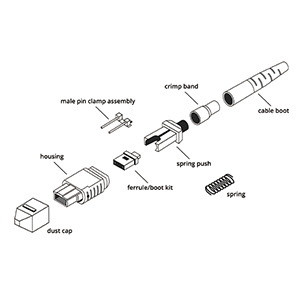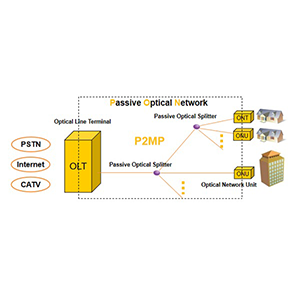Ethernet switches undoubtedly play an important role in network infrastructure. This article will focus on managed Ethernet switches. We will first outline the differences between unmanaged and managed Ethernet switches, and analyze the differences between different types of switches in terms of functions, performance, etc. Next, we will define the core concepts of managed Ethernet switches and list their main technical features and advantages.
We will introduce the main functions of managed switches in detail, including VLAN division and management, port security and access control, traffic monitoring and bandwidth management, as well as remote management and troubleshooting. In addition, we will explore the typical application scenarios of managed Ethernet switches in enterprise LANs, industrial control networks, carrier access networks, and data center networks.
Types and Features of Ethernet Switches
Let me give you an overview of the main differences between unmanaged and managed Ethernet switches, as well as their differences in functions and performance.
The difference between unmanaged and managed switches:
(1) Unmanaged switches
- Also known as plug-and-play switches, they are usually firmware-driven and do not require complex configuration.
- Have basic switching functions, such as MAC address learning, VLAN isolation, etc.
- Suitable for small network environments that do not require complex management.
- The price is low, suitable for deployment by users with limited budgets.
(2) Managed switches
- Have rich configuration and management functions, and can be configured through interfaces such as Web and CLI.
- Supports advanced features such as VLAN, QoS, secure access control, and SNMP monitoring.
- Can conduct in-depth management and control of the network, suitable for large and complex network environments.
- Higher price, but can provide more powerful network optimization and operation and maintenance capabilities.
Differences in functions and performance between different types of switches:
(1) Functional differences
- Unmanaged switches provide basic Layer 2 switching capabilities and are relatively simple in function.
- Managed switches have a wealth of network management functions, such as VLAN, QoS, and security.
- Managed switches can achieve more sophisticated network optimization and control through configuration.
(2) Performance differences
- Unmanaged switches usually use simpler hardware architectures and have relatively low performance.
- Managed switches have more powerful hardware resources such as CPU and memory, and have better performance.
- Managed switches can support higher line-speed forwarding capabilities and concurrent connections.
(3) Differences in scalability
- Unmanaged switches generally cannot be upgraded in software or expanded in functionality.
- Managed switches usually support firmware upgrades and can add new functional modules.
- Managed switches can adapt to changing network needs and technological developments.
(4) Differences in monitoring and maintenance
- Unmanaged switches cannot provide rich monitoring and diagnostic functions.
- Managed switches can be remotely monitored and maintained through protocols such as SNMP and Syslog.
- Managed switches are helpful for network administrators to troubleshoot and optimize performance.
In general, unmanaged switches are suitable for small networks, while managed switches are suitable for large and complex network environments. The two have significant differences in functionality, performance, scalability, and maintainability. When deploying, you need to make a choice based on actual needs.
Definition and features of managed Ethernet switches
Let me introduce you to the definition and main features of managed Ethernet switches in detail.
Definition of managed Ethernet switches:
Managed Ethernet switches are advanced network switching devices that provide rich network management and configuration functions in addition to basic Layer 2 switching functions. With managed switches, network administrators can control and optimize the network more finely to meet the needs of different businesses and users.
Compared with unmanaged switches, managed switches have the following core features:
- Support remote configuration and management through Web pages, command line interfaces, etc.
- Provide advanced functions such as secure access control, virtual local area network (VLAN), quality of service (QoS), etc.
- Can monitor network performance indicators and provide diagnosis and troubleshooting functions
- Software upgrades and function expansions can be performed according to actual needs
In short, managed switches provide network administrators with more powerful control and optimization capabilities to meet various management needs in complex network environments.
Main technical features and advantages of managed switches:
(1) Rich configuration and management functions
- Supports multiple management interfaces such as Web UI, CLI, SNMP, etc.
- Configurable VLAN, QoS, secure access control, link aggregation, etc.
(2) Network monitoring and diagnostic capabilities
- Provides real-time monitoring of port status, traffic, error statistics, etc.
- Supports Syslog, RMON and other protocols for network performance analysis
(3) Reliability and scalability
- Redundant power supply and fan design to improve equipment reliability
- Supports modular hardware and software upgrades for future expansion
(4) Security guarantee
- Supports 802.1X, MAC address binding and other security access control
- Can defend against common network attacks and protect network security
(5) Energy efficiency
- Adopt advanced power supply and heat dissipation technology to reduce energy consumption and carbon emissions
- Support port-based energy-saving mode and dynamically adjust power consumption according to load
In short, managed Ethernet switches are significantly superior to ordinary switches in terms of functions, performance, reliability, security and energy efficiency, and are an ideal choice for building efficient and secure networks.
Main functions of managed Ethernet switches
Let me introduce you to the main functions of managed Ethernet switches in detail.
VLAN division and management:
- Managed switches support VLAN functions based on ports or MAC addresses.
- Users can flexibly divide VLANs and isolate broadcast domains according to business needs.
- Supports functions such as inter-VLAN routing and VLAN trunking to achieve cross-VLAN communication.
- VLANs can be dynamically managed through protocols such as GVRP to simplify network configuration.
Port security and access control:
- Supports port security access control based on MAC address and IP address.
- The number of devices and MAC addresses allowed to access the port can be limited.
- Supports standard protocols such as 802.1X to achieve user-based authentication and authorization.
- Provides mechanisms such as ACL and port isolation to defend against common network attacks.
Traffic monitoring and bandwidth management:
- Real-time traffic statistics and historical trends of each port can be monitored.
- Supports remote network monitoring and analysis based on SNMP.
- Prioritize forwarding of key business traffic through QoS policies.
- Can limit the bandwidth of ports or VLANs and allocate network resources reasonably.
Remote management and troubleshooting:
- Supports multiple management methods such as Web management interface and command line interface.
- Remote centralized monitoring and management can be achieved through protocols such as SNMP and Syslog.
- Provides detailed system logs and debugging information to facilitate fault analysis and location.
- Supports RMON, mirroring and other functions to assist in the troubleshooting and diagnosis of network problems.
In short, managed switches provide a series of powerful network management functions such as VLAN, secure access control, traffic management, and remote management, which can help network administrators efficiently optimize and maintain enterprise networks. These functions are especially important in large and complex network environments.
Application scenarios of managed Ethernet switches
Let me introduce you to the main application scenarios of managed Ethernet switches.
Enterprise LAN:
- Enterprise networks usually require VLAN division, secure access control, traffic management and other functions.
- Managed switches can effectively meet the flexibility, security and manageability requirements of enterprise networks.
- Appropriate network policies and bandwidth allocation can be configured for different departments, businesses and users.
- It is conducive to improving the overall performance and reliability of enterprise networks.
Industrial control network:
- Industrial automation networks have high requirements for network configuration and monitoring.
- Managed switches provide port security, VLAN isolation, QoS and other functions to ensure reliable communication of industrial control equipment.
- Supports redundant power supply, fan and other designs to enhance the durability of equipment in harsh industrial environments.
- Helps to achieve centralized management and fault diagnosis of industrial networks.
Carrier access network:
- Carrier networks need to support large-scale user access, rich VLAN functions and powerful management capabilities.
- Managed switches can support carriers to provide value-added services such as IPTV and VoIP.
- It can meet the strict operation and maintenance requirements of carriers for the network through a variety of management interfaces and security mechanisms.
- Helps carriers build a scalable and reliable access network architecture.
Data center network:
- Data center networks have high requirements for network performance, security and manageability.
- Managed switches can provide high-speed, low-latency Layer 2 forwarding capabilities and support large-scale virtual machine deployment.
- Through VLAN, QoS, secure access control and other functions, the priority and isolation of key business traffic are guaranteed.
- It is conducive to centralized monitoring and fault diagnosis of data center networks and improves overall reliability.
In short, managed Ethernet switches are widely used in enterprise, industrial, operator and data center network environments that require high performance, high reliability and centralized management with their rich network management functions, becoming key equipment for building intelligent and secure networks.
Summary
The reasonable selection and configuration of managed Ethernet switches is crucial for efficient and secure network infrastructure. Our company has long focused on the research and development and production of network equipment and its supporting products, and has rich industry experience. Our managed switch products have reached the industry-leading level in terms of functions and performance, and can meet your demanding needs for intelligent network construction.
Whether you need to deploy managed switches in an enterprise, factory, or operator network, we can provide you with customized solutions. At the same time, our professional team will provide you with a full range of technical support, including on-site surveys, solution design, and equipment configuration and maintenance. Contact us now to learn more about the application of managed Ethernet switches.
Managed Ethernet Switch FAQ
A managed Ethernet switch is a network switch that provides advanced features and configuration options beyond basic switching functionality.
Managed switches allow for remote configuration, monitoring, and management, whereas unmanaged switches have a fixed, basic set of features.
Typical features include VLAN support, port mirroring, link aggregation, Quality of Service (QoS), and SNMP-based management.
Managed switches are used when more advanced networking capabilities are required, such as in enterprise, industrial, or service provider environments.
Managed switches can be configured and monitored through a web-based interface, command-line interface, or network management software.
They are commonly deployed in office networks, data centers, industrial facilities, and service provider infrastructure.
Yes, managed switches generally have a higher price point due to the additional hardware, software, and management capabilities.
While possible, managed switches are typically overkill for basic small office or home networking needs, where an unmanaged switch may suffice.
Key factors include port count, supported features, performance, and integration with your existing network infrastructure.
Managed switches offer enhanced security features like access control lists, port security, and RADIUS authentication.



